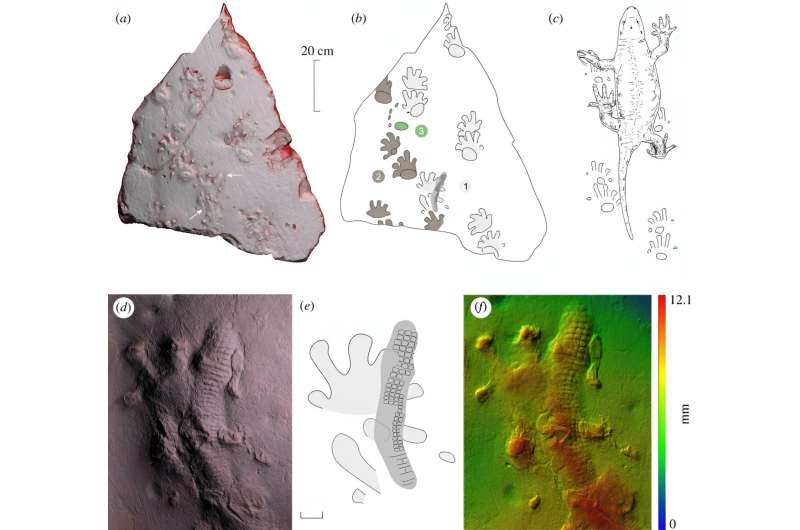May 28, 2024 report
This article has been reviewed according to Science X's editorial process and policies. Editors have highlighted the following attributes while ensuring the content's credibility:
fact-checked
peer-reviewed publication
trusted source
proofread
Discovery of ancient rock impression suggests ability to form cornified skin goes back to early evolution of tetrapods

A team of geologists, paleontologists and archaeologists affiliated with several institutions in Poland, Czechia and Germany has found evidence suggesting that the ability to form cornified skin appendages is not unique to terrestrial vertebrates, but goes back to the early evolution of tetrapods.
In their paper published in the journal Biology Letters, the group describes their analysis of impressions on a stone slab made hundreds of millions of years ago.
In 2020, a team of archaeologists uncovered what they described as an ichnofossil specimen in Bieganów, Poland. The slab of Permian rock did not hold fossilized bones, but instead revealed other evidence of ancient creatures—in this case, multiple foot and belly prints.
For this new study, the team analyzed the slab and were able to partially identify some of the creatures that left the impressions behind millions of years ago. They also found evidence showing that the ability to form cornified skin appendages goes all the way back to early tetrapods.
Corneous scales are considered to be appendages when they appear on the skin, such as those on snakes and lizards. Prior research has suggested that these scales play an evolutionary role in the development of fur and feathers. Because of this, they are thought to be involved in the development of all amniotes.
Prior research has also found that some amphibians can form these appendages as well. What has not been clear, however, is whether the amphibians developed them on their own or if there was a common ancestor of amphibians and amniotes that had corneous scales. In this new study, the research team has found evidence of the latter theory.
In studying the slab, the research team found hundreds of foot and belly prints. Many of the belly prints clearly showed scales. The team also found that many of the prints were so clear that they were able to see that the scales were likely made of keratin. The creatures that made the prints lived before the ancestors of reptiles and mammals split from amphibians—a find that appears to settle the question of whether some amphibians developed corneous scales independently.
More information: Sebastian Voigt et al, A diadectid skin impression and its implications for the evolutionary origin of epidermal scales, Biology Letters (2024). DOI: 10.1098/rsbl.2024.0041
Journal information: Biology Letters
© 2024 Science X Network





















